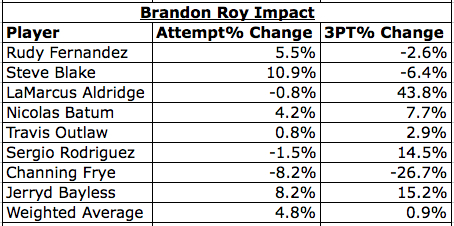One thing I should have done in my study was take teammates more into account. I took a look at the top subs of some of the players, which was hinting at the issue, but I didn’t delve into it further. A player’s impact on his teammates’ three-pointers could be deceiving if he tends to be on the floor with certain teammates frequently. For example, I pointed out that one of Dwyane Wade’s top subs was Daequan Cook, a long-range bomber. This makes Wade’s impact on team three-point shooting look smaller than it actually is. What about the players who often play next to long-range shooters? Dwight Howard plays a lot of minutes with Rashard Lewis, so it makes sense that the Magic shoot a lot of threes when Howard is on the court (but not necessarily because of Howard).
To get around this, you have to look at it on a player-by-player basis. Below I have tables for four of the players in the original study. Each table includes the superstar’s impact on the three-point attempt frequency and efficiency for every player on his team. At the bottom, I calculate a weighted average.




When we use this approach, the results tell us something different. Dwight Howard still has a large impact, but it’s no longer the biggest of the bunch. On average, Dwyane Wade increased each Heat player’s three-point attempt percentage by 11 percent. Even Steve Nash, who I originally said had no effect, creates an average increase of 4.1% for his teammates. Additionally, Nash makes his teammates shoot three-pointers more efficiently, raising their 3PT% by 4.3%.
This new data may change the specifics, but it further confirms the original idea: superstars create good three-point looks for their teammates.